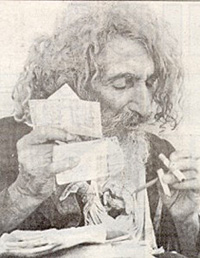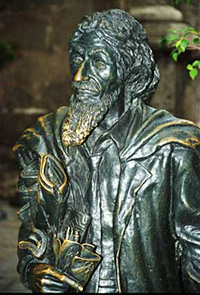 |
 |
 |
 Travel & Outdoors | January 2007 Travel & Outdoors | January 2007  
In Death, Havana Vagabond Becomes an Icon of Good Luck
 Doreen Hemlock - South Florida Sun-Sentinel Doreen Hemlock - South Florida Sun-Sentinel


| | The statue of a man who once roamed the Cuban city is now a tourist destination. | 
| |
Havana - For good fortune, visitors to Rome throw coins in a fountain. In China, they rub their hands on the heads or the tails of turtle statues. But in Cuba's capital, there's a new custom: to stroke the sculpture of the "Gentleman from Paris."

Locals and foreign tourists seeking luck routinely stop at the bronze statue by the San Francisco Church in colonial Havana. Touch the gentleman's index finger for prosperity, some say, or caress his beard to return to the city.

"It really works. I did it the last time I was in Cuba, and look, I'm back," said Pedro Gomez, 53, of Guadalajara, Mexico, admiring and rubbing the statue again recently.

So many people stroke the statue while making wishes that the dark patina has worn off its index finger and beard.

Cuban girls celebrating their 15th birthdays regularly show up in gowns to take pictures with the two-tone gentleman. Photographers say the contact brings good luck.

"All the girls who turn 15 do it," said a giggly Yisel Pinon. "I don't know why."

In real life, the man immortalized as the Gentleman from Paris was neither noble nor French. He was a vagabond from Spain who roamed Havana wearing dark clothes and a cape and often made drawings or other gifts for those he met.

"He could talk on any topic, never used vulgar words, drew things just as they were and never begged," said Milagros Lopez, 45, a psychologist who knew the gentleman before his death in 1985.

He was born Jose Maria Lopez Lledin in Spain's Lugo province in 1899 and moved to Cuba in 1913. He once said he took his title from a French novel. Others claim romantic roots - of his love from Paris who died at sea, or a Cuban woman schooled in France who dressed him in silks and later abandoned him.

What's generally agreed upon is that Lopez began wandering the streets after being jailed in 1920 for a crime he didn't commit (the nature of the crime remains in dispute).

In 1977, a sympathetic doctor placed the 78-year-old in a psychiatric hospital, where he was cared for until his death eight years later.

But Havana's official historian, Eusebio Leal, who has led the impressive restoration of the colonial zone, had the Spaniard's bones exhumed and placed inside the San Francisco Church. The statue by sculptor Jose Villa Soberon was added outside the church in 2001. | 
 | |
 |



